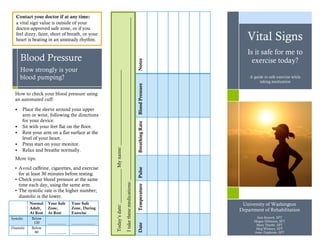
Vital Signs Brochure FINAL version
- 1. How to check your blood pressure using an automated cuff: • Place the sleeve around your upper arm or wrist, following the directions for your device. • Sit with your feet flat on the floor. • Rest your arm on a flat surface at the level of your heart. • Press start on your monitor. • Relax and breathe normally. More tips: • Avoid caffeine, cigarettes, and exercise for at least 30 minutes before testing. • Check your blood pressure at the same time each day, using the same arm. • The systolic rate is the higher number; diastolic is the lower. Vital Signs Is it safe for me to exercise today? A guide to safe exercise while taking medication University of Washington Department of Rehabilitation NotesBloodPressureBreathingRatePulseTemperatureDate Today’sdate:______________Myname:_______________________________ Itakethesemedications:___________________________________________________________________ Normal Adult, At Rest Your Safe Zone, At Rest Your Safe Zone, During Exercise Systolic Below 120 __________ _____________ Diastolic Below 80 __________ _____________ Sam Bennett, SPT Megan Hillmann, SPT Mary Thurtle, SPT Meg Whitney, SPT Anne Ziegltrum, SPT Blood Pressure How strongly is your blood pumping? Contact your doctor if at any time: a vital sign value is outside of your doctor-approved safe zone, or if you feel dizzy, faint, short of breath, or your heart is beating in an unsteady rhythm.
- 2. The most accurate way to take your temperature is with a digital thermometer by mouth. How to take your temperature: • Place the bulb of the thermometer under your tongue. • Close your mouth. Wait until you hear a beep. More tips: • Always check the instructions for your thermometer before using. • Do not use glass thermometers containing mercury. How to take your pulse: • Position yourself near a clock. • Turn hand palm up. Place two fingers on your wrist. Do not use your thumb to feel for your pulse. Do not push too hard. • Slip fingers off-center toward thumb. When you feel your pulse, count the number of beats in one minute. How to check your breathing rate: • Find someone to help with these steps. Sit upright with your helper standing next to you. • Your helper should see your chest rise with each breath. • When you are relaxed, have them count the number of chest rises you take within one minute. • If no one is available to help, try to relax, breathe naturally, and count the number of breaths you take in one minute. More tips: • Remove bulky clothing • Have your helper place a hand on your back to feel for each breath. Breathing Rate How many breaths do you take each minute? Normal Body Temperature Fever Contact Your Doctor If… 98.6° Above 99.5° Below 95° Above 103° Pulse How many times does your heart beat each minute? Temperature How warm is the inside of your body? Normal Adult At Rest Your Safe Zone, At Rest Your Safe Zone, During Exercise Above 12 __________ _____________ Below 20 __________ _____________ Normal Adult At Rest Your Safe Zone, At Rest Your Safe Zone, During Exercise Above 60 __________ _____________ Below 100 __________ _____________ Vital Signs, Medications, and Exercise: When your doctor takes your body temperature, pulse, breathing rate, and blood pressure, they are looking at your “vital signs”. These vital sign values tell us that the heart, lungs, and other body systems are working well to keep you safe. Medications can change these values so that they no longer fall within normal ranges for most adults. This change can make people nervous to exercise. This brochure serves as a tool to be filled out by your doctor to tell you what vital sign values are safe for you both at rest and while exercising. There is also a vital signs log to encourage you to monitor and track your vital sign values.